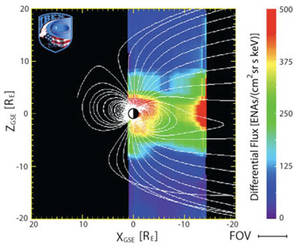The northern lights have recently been in the news this week, and they are caused by the solar wind, which is made up of energetic charged particles thrown off the sun being trapped by the earth's magnetic field then crashing into the atmosphere exciting the air molecules, making them glow. Unfortunately for those trying to understand this the moving charged particles are effectively an electric current, and electric currents produce a magnetic field, altering where the particles path, changing the magnetic field etc.
To make it even more difficult, the charged particles are essentially invisible as they fly through space, and the effect they have on the magnetic field is only measurable by actually putting an instrument in that position, and there is a limit to the number of satellites you can use at once.
The Interstellar Boundary Explorer or IBEX satellite was actually designed to look at the heliopause which is where the sun's magnetic field and solar wind becomes overwhelmed by the galactic solar wind. At this junction sometimes a charged nucleus will pick up electrons becoming a neutral atom, these are then unaffected by magnetic fields, and will continue in a straight line, only affected by gravity. So if some of them reaches IBEX satellite you can measure the direction they came from. IBEX has built up some interesting pictures of the heliopause, but sometimes in its orbit it looks at the earth where something very similar is happening where the earth's magnetic field is being overwhelmed by the sun's magnetic field.
The result is an admittedly low resolution image of the magnetic tail or plasma sheet that streams out behind the earth. Dave McComas who is the principal invetigator on the mission has published two images of this tail, and they show it is a very dynamic place with an image from one orbit showing it as a smooth tail, but the second has a lump of plasma being pinched off, much closer to the earth than current theories were expecting, possibly because the tail was being squeezed by the solar wind.
Understanding these processes is becoming more important as the sun is moving into a more active part of its 11 year solar cycle and solar storms have knocked out satellites, telegraph and even electricity grids, and it is an interesting example of an instrument designed to investigate something very abstract being used much closer to home.
 |  |










Comments
Add a comment